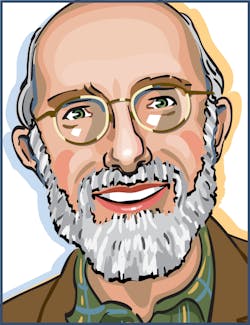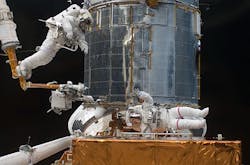
December 2013 marks the 20th anniversary of what may be the most dramatic rescue in the history of astronomy: the first space shuttle mission to the Hubble Space Telescope. On November 13, 2013, the MIT Aeronautics and Astronautics department will host a symposium on rescuing hubble, with speakers including astronauts, scientists, and engineers who helped diagnose and repair an optical flaw in Hubble's main mirror that went unrecognized until after its launch in April 24, 1990.
Hubble was finished before the 1986 Challenger disaster and sat for years in a clean room waiting to be launched, but it was never tested as a complete instrument on the ground. The flaw came to light when astronomers could not bring the telescope to a sharp focus. A series of diagnostic tests and forensic analysis by a tiger team of optical experts found that the 2.4 m primary mirror had been perfectly polished to the wrong shape, leaving it with spherical aberration and a Strehl ratio of 0.15 instead of the ideal 1.0. PerkinElmer's Danbury Lab (Danbury, CT), sold to Hughes Aircraft (Culver City, CA) in May 1990, had made the error because technicians had wrongly assembled an optical test set to measure the mirror's shape. Worse, project managers had ignored other test results hinting that something might be wrong.NASA became a laughingstock. The movie Naked Gun 2 1/2 consigned a photo of Hubble to the wall of the "Loser's Bar." Dismayed and bitter, astronomers reacted angrily when NASA offered them computer-enhanced images rather than the sharp ones they had promised. NASA had become the wrong stuff.
But in the background, optical engineers were designing corrective optics to bring Hubble into focus. One set was built into the Corrective Optics Space Telescope Axial Replacement (CO-STAR). Another was installed in a replacement Wide Field and Planetary Camera. Designers of those systems will talk at MIT. So will astronauts from the STS-61 Endeavor mission who planned the first repair mission and installed the replacement equipment 20 years ago in a long series of spacewalks, Story Musgrave, Jeff Hoffman (now an MIT professor), and Tom Akers.
The stakes were high for NASA and the future of astronomy. Astronauts had to improvise at times, but in the end it worked brilliantly. Hubble became a brilliant success, and the world's premier telescope. It is so well-loved by the public that Congress earmarked a chunk of the NASA budget for a final shuttle repair mission in May 2009. And that has paid off in many ways, from spectacular images of young galaxies at the fringe of the universe to detecting the fifth moon of Pluto, a 10 to 25 km iceball, as a single pixel. It's an optical feat that deserves celebration.

Jeff Hecht | Contributing Editor
Jeff Hecht is a regular contributing editor to Laser Focus World and has been covering the laser industry for 35 years. A prolific book author, Jeff's published works include “Understanding Fiber Optics,” “Understanding Lasers,” “The Laser Guidebook,” and “Beam Weapons: The Next Arms Race.” He also has written books on the histories of lasers and fiber optics, including “City of Light: The Story of Fiber Optics,” and “Beam: The Race to Make the Laser.” Find out more at jeffhecht.com.
